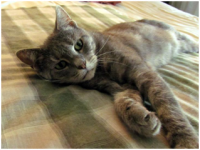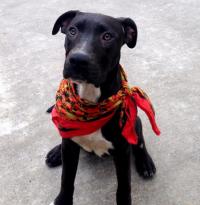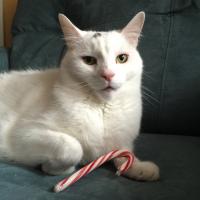Hyperthyroidism
Hyperthyroidism, overactive thyroid glands, is a common condition among cats, particularly those eight years old or older, but is very rare in dogs unless they are receiving too much medication for hypothyroidism (low thyroid).
Cats have two thyroid glands in their necks which secrete thyroid hormone. This substance is involved in many different processes in the body and is essential to life. However, when too much thyroid hormone is secreted by these glands, it can lead to severe symptoms, even death. Knowing the signs and treating the condition can lead to a normal lifespan for your kitty.
Symptoms of Hyperthyroidism
Symptoms of hyperthyroidism can include ravenous appetite, weight loss, increased thirst, increased urination, vomiting, diarrhea, hyperactivity, increased vocalization, and hearing loss. A cat may not have all of these symptoms. Also, any one or even a combination of these symptoms can indicate other conditions. That is why it is so important to see your veterinarian right away and get a proper diagnosis.
Diagnosis of Hyperthyroidism
Diagnosing hyperthyroidism starts with a physical exam. It is very difficult, if not impossible, to feel the thyroid glands of a healthy cat. Conversely, it is easy to feel an enlarged thyroid gland in the neck of a hyperthyroid cat. That discovery along with a fast heart rate, high blood pressure and weight loss makes a veterinarian very suspicious of hyperthyroidism.
The history you give your veterinarian can also make hyperthyroidism likely or unlikely. If your cat has any of the symptoms listed under the section above, he could be hyperthyroid. If he has multiple symptoms, it becomes even more likely. Multiple blood tests are used to confirm your veterinarian’s suspicions.
Relationship to Kidney Function
There is an inverse relationship between thyroid levels and levels of creatinine in the blood (the most important enzyme we can measure to determine kidney function.) As the thyroid level goes up, as in hyperthyroidism, creatinine most often goes down. As we control the thyroid level and get it back to normal, the creatinine may increase, unveiling a formerly masked kidney problem. For this reason, it is essential that every time the thyroid level is checked, the creatinine must be measured as well.
Treatment
There are three treatment options for any cat diagnosed with hyperthyroidism, each with their own benefits and risks. Your veterinarian will assist you in making the best decision for your cat’s treatment, but your options will consist of radioactive iodine therapy, medication, and/or surgery. Diet modifications may also be suggested.
Radioactive Iodine Therapy
This is considered the gold standard for treating feline hyperthyroidism. It is a safe procedure that is used for both people and animals, but requires that radioactive substances be handled, so it must take place at a veterinary center designed specifically for that purpose.
Medication, Surgery and Diet
There are medications that do not cure hyperthyroidism, but control the thyroid hormone level. These medications must be given in the form of pills, oral liquid, or transdermal cream. Periodic blood tests are needed to monitor the thyroid hormone levels and adjust the dosage as needed. There are possible side effects, some of which can be serious.
One or both thyroid glands can be removed surgically if the veterinarian is experienced in this particular surgery. The disadvantages include the risk of damage or accidentally removing the parathyroid glands, the possibility of leaving abnormal thyroid tissue behind, and the need for anesthesia. If the entire thyroid tumor, both glands, and any tissue elsewhere in the body are not removed, many cats end up needing radioactive iodine treatment.
Lastly, since the production of thyroid hormone requires iodine, which is obtained through your cat's diet, some studies have suggested that too little iodine causes hypothyroidism while too much can lead to hyperthyroidism. Based on those findings, a prescription diet has been manufactured by Hill's called Y/D, which severely limits the amount of iodine taken in by your cat.
It is problematic to feed this diet in a multi-cat household because the non-hyperthyroid cats should not eat it. The usage of this diet is also somewhat controversial among veterinarians. There is concern about the effects of a prolonged period of iodine restriction and the diet has not been around long enough to fully know these effects.
All articles are reviewed and maintained by whiskerDocs team of veterinary experts.




